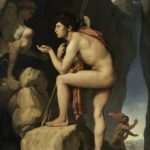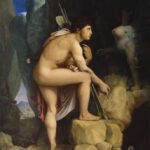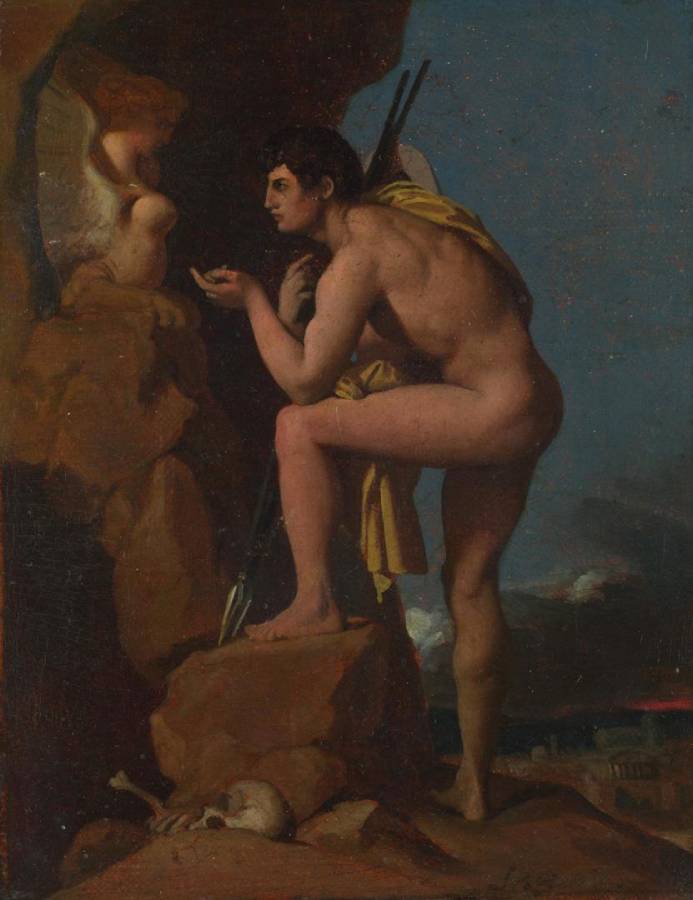Ingres, Jean Auguste Dominique (1780-1867)
Oedipe et le Sphinx (Oedipus and the Sphinx)
c.1826
Oil on canvas, 17.5 × 13.7 cm
National Gallery, London
Oedipus, a figure from Greek mythology, stands nude and in profile before the Sphinx, who guards the entrance to the ancient city of Thebes. The Sphinx – a monster with the face, head and shoulders of a woman, a lion’s body, and bird’s wings – asks Oedipus to solve the riddle she poses to all travellers seeking to enter the city: ‘What has a voice and walks on all fours in the morning, on two at noon, and on three in the evening?’ Oedipus correctly answers that it is man who crawls on all fours as a child, walks on two legs as an adult, and uses a walking stick as a third leg in old age. The bones of a previous traveller, killed by the Sphinx for having failed to solve the riddle, lie at the bottom of the picture. Thebes is visible in the distance on the right.
The theme of a monster defeated by human intelligence clearly appealed to Ingres. The picture also complements another of his paintings, Angelica saved by Ruggiero, which shows a chivalrous knight attacking a sea monster to save a princess. But this is also a painting of a man facing his destiny, as Oedipus’s actions will lead him to become King of Thebes, as the oracle predicted at his birth, and to unknowingly marry his own mother, Jocasta. This unwitting tragedy and its consequences is the drama of Oedipus Rex, the middle play of Sophocles‘ Theban Plays.
This painting is a later, and smaller, version of one painted in 1808 and subsequently reworked in 1827 (Louvre, Paris). The first version of Oedipus and the Sphinx was essentially a figure study that Ingres painted while studying at the French Academy in Rome. It was sent to Paris to be judged by members of the Institut de France. As required by the Institut’s rules, the figure of Oedipus was based upon a live model, although the pose was derived from the classical statue, Hermes Fastening his Sandal (Louvre), a Roman marble copy of a lost Greek bronze. Oedipus’s body is presented as an arrangement of geometrical shapes; for example, the triangle formed by his left arm, thigh and chest is mirrored and inverted by his left upper arm and forearm. The use of profile for both Oedipus and the Sphinx, together with the shallow space in much of the picture, recalls classical friezes and ancient Greek vases, which Ingres used as the sources for his deliberately classical artistic style .
The painting was once owned by Edgar Degas, who bought it for his private collection in the mid-1890s. (NG)
Compare:
 Ingres, Jean Auguste Dominique (1780-1867)
Ingres, Jean Auguste Dominique (1780-1867)
Oedipe explique l’énigme du sphinx
1808
Musée du Louvre, Paris
 Ingres, Jean Auguste Dominique (1780-1867)
Ingres, Jean Auguste Dominique (1780-1867)
Oedipe et le Sphinx
1864
Walters Art Museum, Baltimore
See also:
• Degas, Edgar (1834-1917) | Sophocles (c.496 BC-406 BC): Oedipus King of Thebes (English)
